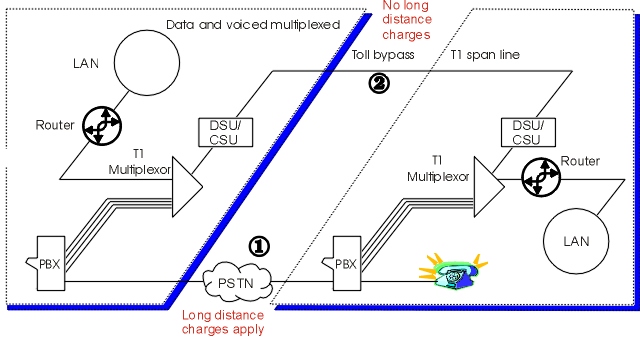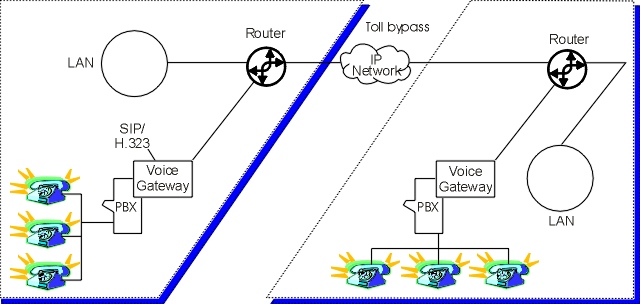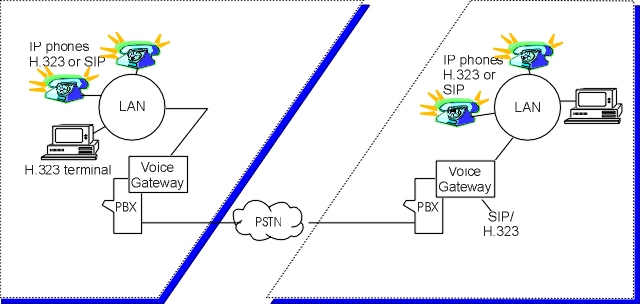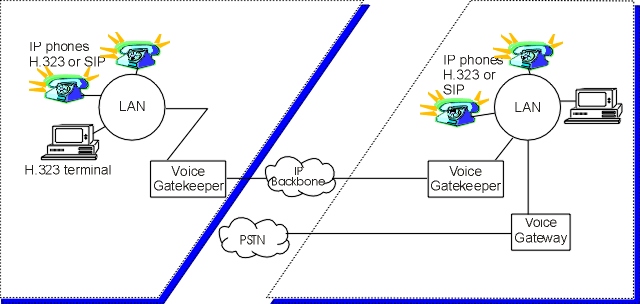Voice over IP Online Course
Lesson 1 - Voice over IP Overview
C. Corporate VoIP
Corporate VoIP
- VoIP on managed IP backbones (toll bypass)
- VoIP takes over the company telephone system
- VoIP end-to-end
Corporate VoIP
Corporate VoIP falls into three distinct types of systems.- Analog at the ends, digital IP in the middle
- Digital IP at the ends, analog in the middle
- Digital IP end to end

Figure 3: Traditional PSTN based long distance
VoIP on managed IP backbones
This is system type one, analog at the ends and digital in the middle. Converting voice to data and sending it across a wide area network to avoid long distance charges (toll bypass) is not a new idea. It is a common ploy used by large organizations to provide telephone services between offices. The current implementation of this idea uses leased lines and the underlying technology such as T1 lines, Frame Relay or ATM. Figure 3 illustrates this technology. Without a leased data line, a call must enter the public telephone network (PSTN) and long distance charges apply. With a leased line, voice and data can be multiplexed and sent over long distance while avoiding long distance charges.Voice must be digitized before it can be sent over those same lines but VoIP packetizes them as well and uses IP to transmit the data.
Why bother packetizing voice data? Because the WAN uses IP technology to move data, and voice must be seen as data to make it across.
Figure 4: Voice on a managed IP backbone
Because a traditional voice system is used inside the organization, all the telephone lines are routed to a PBX. To packetize the voice, a voice gateway is used. This may be a separate box or it could be a component of the PBX. The digitized voice is than routed over the WAN via routers. H.323 and SIP are the two common control protocols used for VoIP. The gateway has many functions, just one of which is to look up the address of the person being called and make a connection. A gateway is a machine which connects two different types of systems. Since the machine connects an analog and digital system, gateway is the correct term for it. The relationship of these components is illustrated in figure 4.

Figure 5: VoIP takes over the company telephone system
VoIP takes over the company telephone system
The second scenario involves an IP based telephone system replacing the analog system inside the organization. Earlier, this was characterized as the digital at the ends, analog in the middle system. Analog in the middle because telephone calls must still funnel into the PSTN to reach outside parties or branch offices if the company doesn't have a managed IP backbone to those offices. See figure 5.Installing an IP based telephone system may be attractive if the company wants to manage a single unified communication system. For example, only one wire has to be routed to each workstation instead of separate LAN and telephone cables. It is easier to make moves, adds and changes on an IP based telephone than a traditional PBX system. The drivers for this technology are explored in greater depth in an upcoming section.
In this system, telephones are IP based or the user uses the communication software of her computer. Note that the telephones are connected to the LAN and that therefore, the telephone system is dependent on the data network being configured and functioning properly. Since data networks don't traditionally approach telephone networks in reliability, this could prove a challenge.
Figure 6: VoIP end-to-end
VoIP end-to-end
VoIP end-to-end is a combination of the previous two systems and is characterized as being digital at the ends as well as digital in the middle. Not only is the telephone system digital but the network which carries voice to the other offices of an organization is also digital.Figure 6 illustrates the system. Note that the devices that connect different parts of the pure VoIP system are called gatekeepers, not gateways. The gatekeeper is used to coordinate voice communications across the IP backbone. Since all portions of the system are digital VoIP, a gatekeeper is used, not a gateway. A gateway is used when connecting different types of systems, such as a digital VoIP system to an analog voice system. Note that even users of a pure VoIP system still need to dial outside the organization and this connection to the public telephone system requires a voice gateway.
[Top of page][On to next section]
